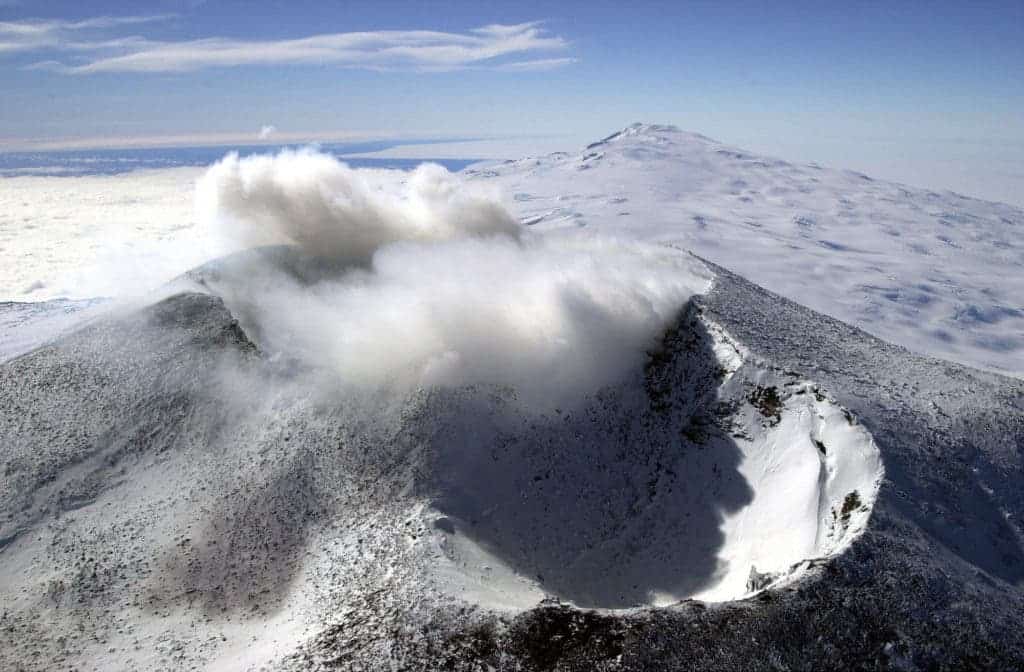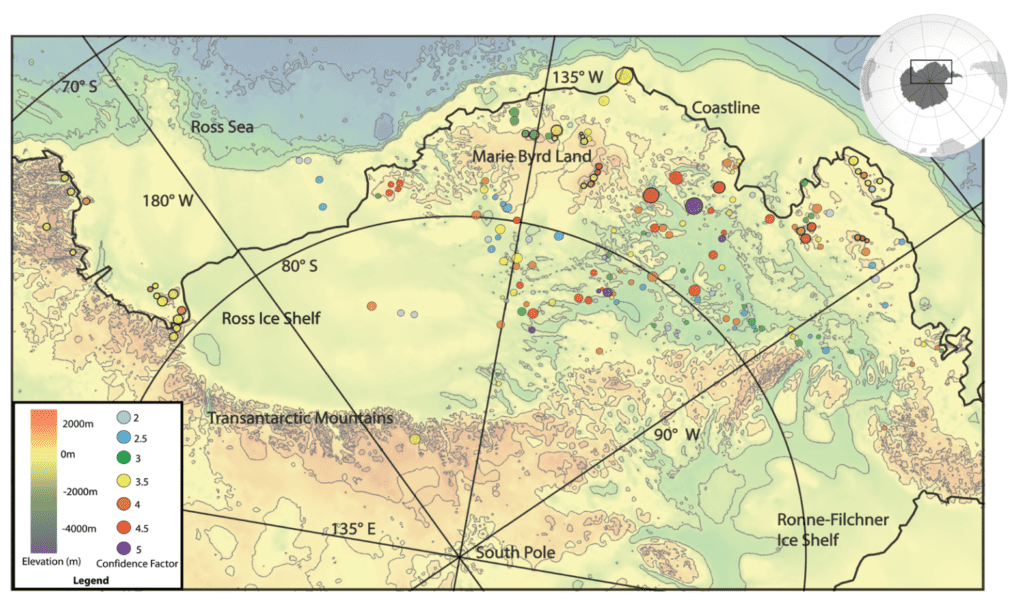
Aerial photo of Mount Erebus gushing smoke and ash from Ross Island, Antarctica. Credit: Wikimedia Commons.
Southwestern Antartica is now home to the densest concentration of volcanoes in the world after scientists uncovered 91 volcanoes some 2 km beneath the continent’s thick ice sheet. The discovery raises the volcano tally on the icy continent to 138 and many more are likely still hidden from our sight. The big question on everyone’s mind right now is how active some of these volcanoes are. One single eruption might be enough to dramatically destabilize an already fragile region causing melting and driving sea level rise at an accelerated rate.
Fire and ice
For more than a century, people have known that Antarctica is particularly prone to volcano formations as explorers would often report about basalt rocks peaking out of the ice. Researchers working with the Edinburgh volcano survey were interested in learning just how many volcanoes they could find along the underside of the West Antarctic ice sheet, which is far less inhospitable and easier to study.
The team used a combination of on-site measurements made by previous groups which surveyed the Antarctic ice sheet with ice-penetrating radar, along with satellite and database records from aerial surveys.
[ALSO SEE] Volcano facts
After counting the number of protruding volcanic cones sticking out of the ice, the team found a staggering 91 previously unknown volcanoes concentrated in a region known as the West Antarctic rift system, which stretches 3,500km from Antarctica’s Ross ice shelf to the Antarctic peninsula. These newly found volcanoes range in height from 100 to 3,850 meters.
“We were amazed,” glacier expert and lead-author Robert Bingham told The Guardian. “We had not expected to find anything like that number. We have almost trebled the number of volcanoes known to exist in west Antarctica. We also suspect there are even more on the bed of the sea that lies under the Ross ice shelf, so that I think it is very likely this region will turn out to be the densest region of volcanoes in the world, greater even than east Africa, where mounts Nyiragongo, Kilimanjaro, Longonot and all the other active volcanoes are concentrated.”

Map of obscured cone-like structures across the West Antarctic Rift System.The
circle colour represents the confidence factor used to assess the likelihood of cones being subglacial volcanoes, and the circle size is proportional to the cone’s basal diameter.
Circles with black rims represent volcanoes that have been confirmed in other studies. Credit: Geological Surveys.
“The results demonstrate that the West Antarctic Ice Sheet shrouds one of the world’s largest volcanic provinces, similar in scale to the East African Rift System. The overall volcano density beneath West Antarctica was found to be one edifice per 18 500 ± 500 km2, with a central belt along the rift’s central sinuous ridge containing one edifice per 7800 ± 400 km2. The presence of such a volcanic belt traversing the deepest marine basins beneath the centre of the West Antarctic Ice Sheet could prove to be a major influence on the past behaviour and future stability of the ice sheet,” the researchers concluded in their paper.
While staggering in itself, the news is also worrying. If only one of these volcanoes were to erupt, the west Antarctic fragile ice sheets could collapse with serious environmental consequences. Right now, no one knows for sure how many of these volcanoes are active.
Of course, that doesn’t mean that a volcano could blow up at any moment in Antarctica. The vast majority of the world’s known 1,500 and more volcanoes are dormant so statistically, it’s unlikely that any of the newly discovered Antarctic volcanoes are active. For now, we only know their shapes — too little to infer whether the new volcanoes are active, dormant or extinct. But there’s still a chance some could be active.
For instance, Mt Erebus, which is found on Ross Island, is an active Antarctic volcano which erupted in 2015. In the last century or so since humans have observed first-hand Antarctica, no volcano has erupted in west Antarctica and likely hasn’t for long before humans set foot on the continent. Another reason to be optimistic about these new volcanoes is that they’re located away from tectonic plate margins. Earthquakes and active volcanoes almost unanimously occur at the tectonic plate boundaries.
In any event, these new volcanoes and the others likely to follow will have to be closely monitored.
The findings were reported in a special Geological Society publication series.









